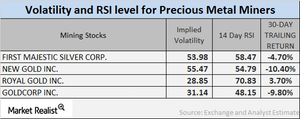How Mining Stock Volatility Numbers Are Moving Now
First Majestic, New Gold, Agnico, and Silver Wheaton now have RSI scores of 60.5, 56.2, 57.6, 59.6, respectively.
Nov. 20 2020, Updated 4:26 p.m. ET

Mining stock evaluation
Investors are, of course, constantly speculating about the impact of the Fed’s upcoming rate hike decision in June on precious metals. While there are many important indicators that investors can keep track of during such times of speculation, we’ll focus here on 14-day RSI (relative strength index) scores and implied volatility.
The Physical Silver Shares (SIVR) and Physical Swiss Gold (SGOL) have regained 1.5% and 1.3%, respectively, on a trailing-five-day basis, likely due to the recent rebound in precious metals. But mining shares have seen losses over the past few days, regardless of this rebound.
Implied volatility
Call implied volatility considers changes in an asset’s price, given variations in the price of its call option. In times of market turbulence, volatility usually rises.
On May 23, 2017, the implied volatilities of First Majestic Silver (AG), New Gold (NGD), Agnico-Eagle Mines (AEM), and Silver Wheaton (SLW) stood at 52.8%, 45.8%, 31.6%, and 30.8%, respectively. Remember, mining company volatility is often higher than precious metals volatility.
RSI scores
A 14-day RSI score above 70 tells us that a stock price might fall, but a score below 30 indicates that a stock price could increase. The four previously mentioned miners’ scores have risen due to their higher stock prices.
RSI scores often revive and fall along with rises and falls in companies’ shares.
Specifically, First Majestic, New Gold, Agnico, and Silver Wheaton now have RSI scores of 60.5, 56.2, 57.6, 59.6, respectively.
For ongoing updates on this industry, keep checking in with Market Realist’s Metals and Mining page.
